The AMD Ryzen 5 1600X vs Core i5 Review: Twelve Threads vs Four at $250
by Ian Cutress on April 11, 2017 9:00 AM ESTBenchmarking Performance: CPU Office Tests
The office programs we use for benchmarking aren't specific programs per-se, but industry standard tests that hold weight with professionals. The goal of these tests is to use an array of software and techniques that a typical office user might encounter, such as video conferencing, document editing, architectural modelling, and so on and so forth. At present we have two such tools to use.
PCMark8
Despite originally coming out in 2008/2009, Futuremark has maintained PCMark8 to remain relevant in 2017. On the scale of complicated tasks, PCMark focuses more on the low-to-mid range of professional workloads, making it a good indicator for what people consider 'office' work. We run the benchmark from the commandline in 'conventional' mode, meaning C++ over OpenCL, to remove the graphics card from the equation and focus purely on the CPU. PCMark8 offers Home, Work and Creative workloads, with some software tests shared and others unique to each benchmark set.
Chromium Compile (v56)
Our new compilation test uses Windows 10 Pro, VS Community 2015.3 with the Win10 SDK to combile a nightly build of Chromium. We've fixed the test for a build in late March 2017, and we run a fresh full compile in our test. Compilation is the typical example given of a variable threaded workload - some of the compile and linking is linear, whereas other parts are multithreaded.
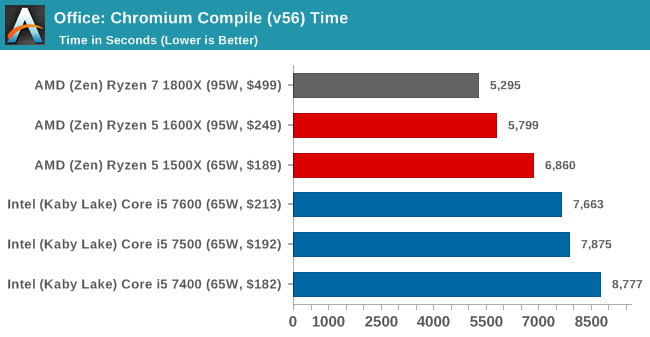
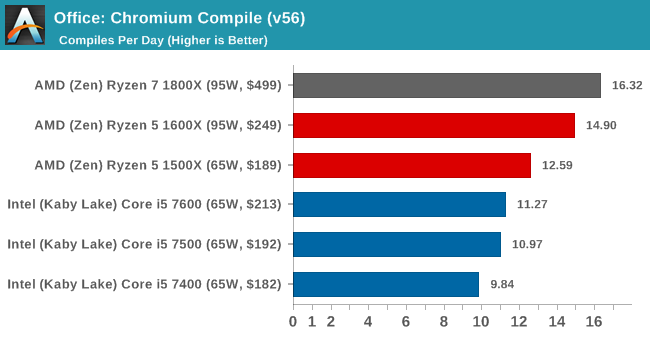
SYSmark 2014 SE
SYSmark is developed by Bapco, a consortium of industry CPU companies. The goal of SYSmark is to take stripped down versions of popular software, such as Photoshop and Onenote, and measure how long it takes to process certain tasks within that software. The end result is a score for each of the three segments (Office, Media, Data) as well as an overall score. Here a reference system (Core i3-6100, 4GB DDR3, 256GB SSD, Integrated HD 530 graphics) is used to provide a baseline score of 1000 in each test.
A note on contect for these numbers. AMD left Bapco in the last two years, due to differences of opinion on how the benchmarking suites were chosen and AMD believed the tests are angled towards Intel processors and had optimizations to show bigger differences than what AMD felt was present. The following benchmarks are provided as data, but the conflict of opinion between the two companies on the validity of the benchmark is provided as context for the following numbers.







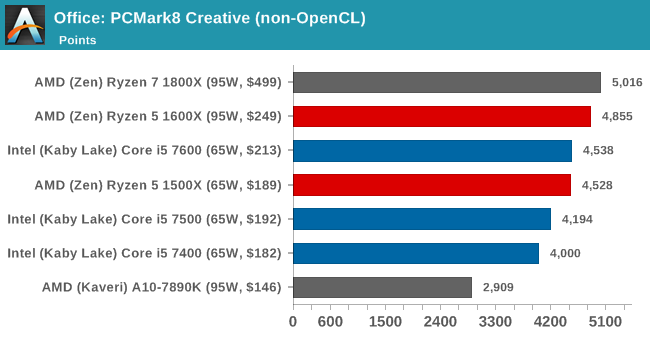
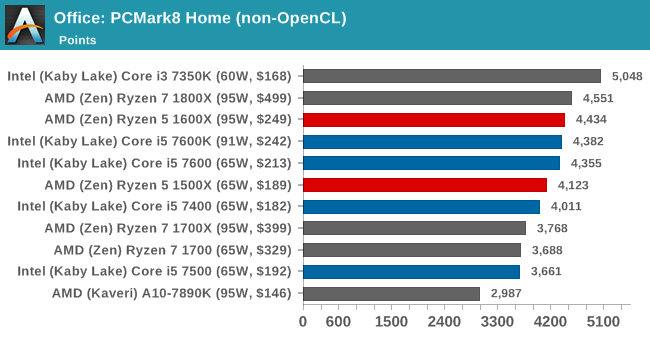
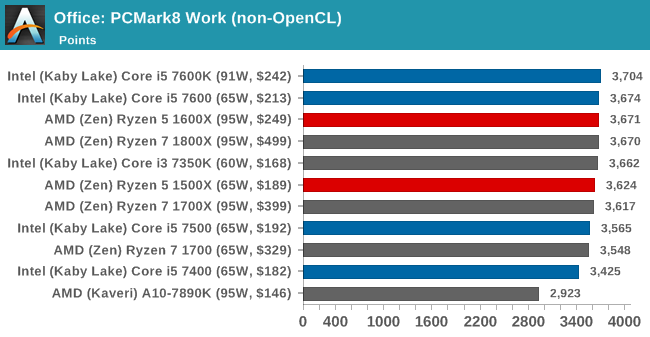








254 Comments
View All Comments
bodonnell - Wednesday, April 12, 2017 - link
Good luck with that. Since Microsoft is only supporting Kaby Lake and Ryzen on Windows 10 I guess you'll be sticking with 2015 and older technology for a while. I bet you desperately hung onto Windows XP too..._zenith - Thursday, April 13, 2017 - link
... except for the fact that many games are console ports now, aaaaannd those are often - usually - already written for DX12, and this will only become moreso once Xbox Scorpio is released, with it's special DX12 hardware optimisations.Notmyusualid - Tuesday, April 18, 2017 - link
@zenithGo ahead and release a DX12-only game.
Let me know how you get on with sales...
Arbie - Wednesday, April 12, 2017 - link
When I do upgrade it will be with AMD. Even where (and if) Intel offers a little more performance per dollar, AMD has amazingly reduced the difference to the point where I can accept it in order to help fuel competition. If the market does not reward AMD for their valiant effort in Zen, the company may be forced to give up. It seems impossible for them to come from behind yet again in such a high-stakes arena. Then Intel will really slack off, and several years from now we'll ALL be worse off than if they were still duking it out.Everyone has to make their own decision, and I couldn't buy the Excavator etc fiascos, but the AMD product is now a real contender - and we need to keep them there.
bodonnell - Wednesday, April 12, 2017 - link
Agreed. I updated my main rig a couple years ago and Intel was really the only option at the time, but if I was in the market now I would definitely be looking at a Ryzen 5 as keeping AMD around is better for consumers. For the money where Ryzen 5 lags it doesn't lag by much (and honestly legacy software that is single threaded was made to work on much lower performance cores) and where it shines (multi-threaded performance) it often beats price comparable Intel processors by a healthy margin.BrokenCrayons - Wednesday, April 12, 2017 - link
Ryzen 5 is an interesting CPU, worth a careful look given the outcome of the benchmarks in this article. Modern workloads seem to be much more likely to use more than one thread and legacy workloads that are single threaded would perform perfectly well on just about any modern CPU so it really isn't a difficult choice to look into a Ryzen 5 if you fall into its price bracket. AMD's APU offerings in the future might offer a better value for some customers since the price of a Ryzen CPU doesn't currently include graphics. People happy with iGPU performance would either require a dedicated graphics card purchase or reuse one thy already have available to build a complete system around a Zen-based processor so those sorts might be better off waiting until the APU versions are released later this year or they might be compelled to purchase a competing Intel product with an iGPU.bodonnell - Wednesday, April 12, 2017 - link
Can't wait to see what AMD does with the Zen core in the mainstream and mobile markets. A well balanced quad core design with a good Polaris based iGPU will be all most consumers need for their day to day use.OddFriendship8989 - Wednesday, April 12, 2017 - link
Is there a reason you don't put in the 7700k in these charts? I mean if you're going to put in 1700X and 1800X, you should put in 7700k too. Plus at just $80 more it's honestly a CPU being considered too people consider the 1600X.vladx - Wednesday, April 12, 2017 - link
Reason is obvious, anandTech have an AMD bias.Outlander_04 - Thursday, April 13, 2017 - link
Unlike yourself, and your well respected neutrality ?